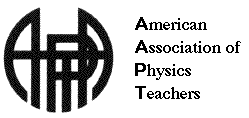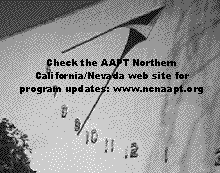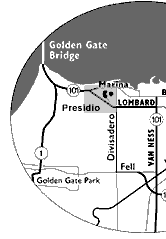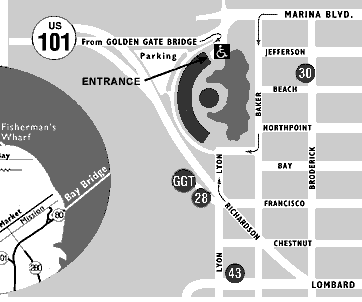



Local Host: Jim Lockhart
Teachers are welcome to contact our President, Mike Ugawa, for a letter of support to assist them obtaining funds and release time to attend this conference."New Teacher Workshop"
10:00 - 4:00 pm, ExploratoriumThis popular workshop, presented by veterans Paul Robinson, Lonnie Grimes, and Dean Baird, is a day-long version of this popular workshop being offered on Friday (instead of Saturday afternoon) so that participants don't have to miss out on the contributed papers. It is intended for teachers who are either new to teaching physics and/or those who have been at it for a while but still feel like they're new! All new teachers will be networked with experienced teachers. The workshop includes valuable teaching tips, goodie bags, raffles where everyone wins, question and answer panels, popcorn, and more! Interested participants should email Paul Robinson at laserpablo@aol.com to register or for more information. No fee.
"Amusement Park Physics"
10:00 - 4:00 pm, ExploratoriumPTRA's from the San Francisco Bay Area will present a workshop specifically for physics teachers. Prepare your students for Physics Day at Great America. Topics will include classroom demos, lab ideas, data collection and analysis. Email Clarence Bakken at cbakken2001@yahoo.com to register or for more information. Note: This workshop has a fee of $36 if your school pays, or $18 if you pay with a personal check. In either case, you get the same material and handouts. Please contact Clarence by Tuesday, Oct. 29.
6:00 - 7:30 Come early, come all for exclusive interaction with the exhibits at the Exploratorium, the world's most famous hands on science museum. Bring your family&emdash;don't miss this one!
NCNAAPT thanks PASCO Scientific for sponsoring the refreshments that will be available at the Friday social. Their continuing support is appreciated by the entire section.
7:30 - 8:15 Paul Doherty, Show and Tell
Probably best known as the Director of the Teacher Institute, Paul first came to the Exploratorium Teacher Institute in 1986 and began his exhibit-based explorations in science. As an author, he has written over two dozen articles for Exploring Snackbook, the Klutz Book of Magnetic Magic, and the book, Traces of Time: The Beauty of Change in Nature. He has even had the pleasure performing physics activities on Late Night with David Letterman. http://www.exo.net/~pauld/
8:15 - 9:30 The Physics Chanteuse
Lynda Williams, physics instructor at Santa Rosa Community College and former go-go dancer, produces and performs science musicals for both scientists and the general public. Her unique mix of science and entertainment has attracted a flurry of media attention from the New York Times, the Herald Tribune, The SF Chronicle, People Magazine, Evening Magazine, Good Morning America, the Osgood File, NPR's West Coast Live, To the Best of our Knowledge, AP Radio News and KPFA's Explorations in Science. According to People Magazine, "Williams puts the fizz back in physics." As The Physics Chanteuse, Williams performs custom cabaret-style shows for academic organizations and corporate clients that are scientifically and technologically sophisticated and tailored to the audience. http://www.scientainment.com/pchant.html
Morning Session, Science Building
7:45 Registration, Coffee, Donuts, and other culinary delights.
8:45 Welcome and Announcements
9:00 Show & Tell
Share your favorite demonstration or teaching tip. Since new teachers and section members will be at this meeting, you are encouraged to dust off some of your oldies but goodies. If you have handouts, please bring 100 copies. Time limit is 5 minutes per person.
10:00 Invited Talk "Detecting Earths"
Debra Fischer, UC Berkeley, fischer@astro.berkeley.eduThere are more than 100 extrasolar planets that have been discovered orbiting nearby stars like our Sun. The planets that were discovered in the early days of planet-hunting appeared to be dramatically different from our own solar system, leading some to speculate that Earthlike planets were rare. That position is softening now as we begin to find Jupiter-like planets at Jupiter-like distances: the detectable architecture of our own solar system. This talk will outline what we've found so far and what our next steps will be to find earth-like planets.
11:00 Invited Talk "The Forgotten Fundamental"
Al Bartlett, Professor Emeritus, University of Colorado at Boulder, Albert.Bartlett@colorado.eduSteady growth is the centerpiece of our economies at the local level, the state level, the national level, and globally. Steady growth is described by the exponential function, and the theme of this talk is that "The greatest shortcoming of the human race is our inability to understand the exponential function." We will look at the arithmetic and consequences of steady growth of populations and of the consumption of resources such as petroleum. We will compare the facts with the public pronouncements of experts, journalists, politicians, and scientists.
12:00 - 1:30 LUNCH: On Your On! (refer to map)
1:30 Raffle/Business Meeting
|
|
|
1:45 Exploring the Invisible
Universe The universe around us teems with invisible energy. NASA's Swift mission, designed to detect bursts of the most energetic photons in the electromagnetic spectrum, has inspired a series of standards-based activities for use in the classroom. This talk will introduce you to these exciting labs designed to improve your student's knowledge of our invisible universe. By using ordinary supplies you can teach your students about light at different wavelengths while at the same time enticing them with NASA science. |
1:45 Teaching Biomolecular
Electronics and Biophotonics at college level: Is it
possible? Science and technology are moving with a fast pace which requires that colleges change their curricula more often than ever before. New technologies, such as nanotechnology, biomolecular electronics, and biophotonics, are going to be driving forces in the photonics and electronics industries in the coming years. We should prepare our students in these challenging subjects. I will describe a proposed teaching strategy to implement a multidisciplinary, hands-on program that can expose physics students to biophysics, protein dynamics, bimolecular devices, and nanotechnology at an early stage of their studies. I will present some examples of experiments that are used in undergraduate research and in an instructional laboratory. |
|
2:00 "Humidity and the COR of
Baseballs" Coors Field, where the Colorado Rockies play baseball, is known to be a "hitter's ballpark." This is not surprising to a physicist because the thinner air at the high altitude of Denver will cause less drag on a fly ball. Major League Baseball has attempted to correct for this effect by humidifying the baseballs used at these games. In principle, the balls will have a smaller coefficient of restitution (COR) and therefore not leave the bat with as high a velocity. We cannot find any published information about the COR as a function of the humidity and will describe our attempts to make the measurements. |
2:00 "The Case for Increased Emphasis
on Life-Science Applications for Students in
Algebra/Trig-Based Physics Courses" Students taking algebra/trig-based introductory courses at the college level differ significantly from those in other introductory courses, such as calculus-based physics. With a preponderance of life science majors and with lessons from the calculus reform movement, a compelling case can be made for increased emphasis of life-science applications in these courses. Data supporting this case and examples of life-science applications will be presented. |
|
2:20 "Model Rockets and Student
Trajectory Simulation" Each year students build a model rocket and provide a simulation (spreadsheet or C++ programming) of the trajectory. This project allows the kids to model drag in a fairly high-fidelity way and model a non-uniform thrust of the solid rocket engine. Students spend about one-third of their time making rocket from kits (according to their previous rocket building experience) and two-thirds of the project time designing, coding and debugging their simulation and documenting their "lessons-learned". |
2:20 "LabVIEW in Beginning
Labs" We have introduced LabVIEW computers into about half of our calculus-based labs. Our physics and engineering students thereby experience programming and interfacing in LabVIEW while dealing with simple equipment and concepts. |
|
2:40 "Experimental Designs in the
Introductory Physics Laboratory" This talk will present three types of experimental designs-verification, application, and investigation designs-that have been developed and implemented in the calculus-based introductory physics laboratory at California State University, Chico. Examples of students' design tasks from mechanics and electromagnetism will be presented. |
2:40 "Understanding Partially
Coherent Light" Light sources with partial coherence are abundant in nature, from LED's to sunlight. With a rotating diffuser, we can demonstrate some of the properties of partially coherent light. I will discuss briefly how to convert a laser beam into a partially coherent light source, and how to use it as a test bench for understanding partially coherent light. |
|
3:00 " Analyzing Galileo's-Ramp
Data" Students have used a new analysis package, Fathom, to analyze data from a variety of "Galileo's Ramp" experiments, sending carts and spheres rolling down tracks. We'll see how the software helps students explore the data in ways that shed light on important conceptual issues in physics, and can help them make strong connections to mathematics. |
3:00 "Detecting Infrared Light,
Herschel's Experiment in the Classroom" Having students perform Herschel's experiment successfully can be troublesome. A method to do it cheaply and effectively will be demonstrated along with other related activities. A JPL video on infrared radiation, a poster, and a color handout will be provided |
|
3:20 "Application of Video and Online
Exercises to the Instruction of Kinematics and the Operation
of the Air Table" Concise video presentation has been prepared to explain how to use and interpret data from an air table. A set of online exercises supports the instruction. The presentation includes video clips and student comments. |
3:20 "Photoelectric Experiment with
Light-Emitting Diodes" A photoelectric experiment is standard in modern physics laboratory courses to illustrate the quantized, photon nature of light. Students observe that the energy of electrons photo-emitted from a cathode depends on the wavelength of the incident light rather than its intensity. Typically, monochromatic light is obtained by using a diffraction grating to separate emission lines from a mercury vapor source, and variable-transmission filters are used to vary the intensity. We have had good results with a simpler arrangement which uses light-emitting diodes (LEDs) with six different wavelengths, from red through UV, as adjustable-intensity light sources. |
|
3:40 "Research Project as a Final Assessment" By giving students appropriate resources and guidelines, they were able to complete individual research projects of their own design. Students were able to define a problem, devise a method for collecting data and prepare a presentation of their methods and results. This final project provided a great deal of motivation for the students and gave them a much better view of the scientific process than most lab experiments. |
3:40 "Experimental Conic
Sections" To fully understand the optics of conic sections, you need to make some drawings. Wally Downs has shown me some elegant ways of generating conic sections with techniques that the company he founded has used for many years to make microwave antennas. Wally is willing to teach these techniques to students who are interested in making such things as parabolic dishes. |
|
4:00 "CPS Course Response System in
Introductory Physics Courses" The CPS course response system allows students to respond to multiple-choice format questions during a class period. Each student purchases a transmitter at the bookstore, and enrolls on-line through the e-instruction web site. The instructor downloads the class list from the web site, and then each student's response is tagged with his or her name. The students can answer without fear of embarrassment, since only the instructor knows which student made which response. |
4:00 "Simple Physics Uses of the
Macintosh Graphing Calculator" A demonstration of some neat uses of the Graphing Calculator that is shipped with the Macintosh. These will vector calculations (2D and 3D), surfaces and tangent lines, E&M fields, and Relativistic transformations. These may cause you to explore this interesting tool for theclassroom. |
|
4:20 "Tuvan Throat Singing and
You" Possibly the coolest thing you can learn to spice up discussions in sound and harmonics is Tuvan throatsinging. Folks from Tuva (popularized in Tuva or Bust! Richard Feynman's Last Journey, by Ralph Leighton) have figured out how to sing so that two notes are heard at the same time. We'll look at spectrogram analyses of various instruments, voice, vowels, then at throat singers. You'll learn some simple techniques to teach yourse |
4:20 "Is Pressure Really Lower in a
Moving Fluid?" The common claim that a moving fluid has a lower pressure than a fluid at rest is examined, for the case of free stream flow. Simple experiments and theoretical arguments will be entered into evidence. Commonly-used demonstrations purporting to illustrate that the pressure is lower in moving fluids and the inappropriate application of the Bernoulli principle are discussed. |
|
4:40 "Lowell saw the canals on Mars,
why can't NASA?" |
4:40 "High Voltage Junk" About 20 years ago, I built a lab set of 1.5 kV high impedance power supplies for a quantitative electrostatics student lab I had devised. The cost per unit was about $100 and maybe 20 person hours each. Mike Kan has shown me how to make 30 kV power supplies from junk. I will demonstrate one that I built in a couple of hours. I will also introduce Mike Kan, a tinkerer par excellence, who could be a valuable resource for many of you. |
|
5:00 "Integrating Modern Topics and
Dark Energy" The idea of dark energy as an explanation for the interesting Type Ia supernova observations and the Boomerang results are discussed in this talk. Last year I knew next to nothing on the subject, but due to persistent pestering by a few students I spent some time at UC Santa Cruz educating myself on the topic. I will also discuss how my student questions on modern physics has evolved into a weekly event titled 'How it Works Wednesday'. |
5:00 "Taking Data Collection to the
Next Level" Using the new Logger Pro scheduled to come out early 2003, you can now enhance learning for your visual learners as well as your math genii. I will show how linking MBL and video will give a great picture of what happened during your experiment. |
REGISTRATION FREE* - What a Deal!*fee is waived for first-time attendees and students! The rest of us pay only $10. A bargain at twice the price!Upcoming Events

- Winter Meeting, AAPT, January, 11-15, 2003, Austin, Texas www.aapt.org
- Spring Meeting, NCNAAPT, Sonoma State University, April 4-5th, 2003 www.ncnaapt.org
- Summer Meeting, AAPT, August 2-6, 2003, Madison, Wisconsin www.aapt.org
- Fall Meeting, NCNAAPT, Lawrence Berkeley Labs, Berkeley, November 14-15, 2003 (Joint meeting with APS)
- Winter Meeting, AAPT, January 24-28, 2004, Miami Beach, Florida www.aapt.org
- Summer Meeting, AAPT, July 31-Aug 3, 2004, Sacramento, CA www.aapt.org
Accommodations
San Francisco has hundreds of hotels to choose from every price bracket. We suggest that you go online at www.sfvisitor.org or call (888) 782-9673 for more information. Also look into staying in Daly City, which is very near San Francisco State.Our host, Jim Lockhart, has put together a page of local motels. Click here to access this page.
Map to the Exploratorium


Map to SFSU


See everyone Friday, either at the workshops or at the social. If not, we'll see you at the meeting Saturday. Good Physics to Everyone!
Updated 10/26/02